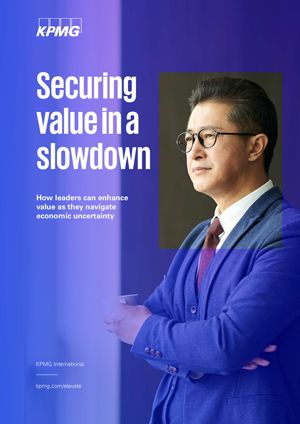Confident decisions in an uncertain world
Navigating investment decisions in times of uncertainty can be challenging. Even before the economic volatility, business leaders were grappling with disruptive trends that were reshaping industries and sectors. The current economic situation has only raised the stakes. As investment risks increase, decisions become more critical — and strategies need to account for more and more unforeseen implications.
In this environment, what decision-makers need is confidence. They want to know how current and future trends could impact their business strategy and markets. They want to identify every opportunity and risk and quantify them. They want a prioritised list of action items that provide in-year savings to fund out-of-year transformation. And they want to know they can deliver on their value creation objectives.
In our report, we demonstrate how business leaders and decision-makers can take key steps to secure value in an economic downturn with confidence.
5 key steps to confident decision-making
Start by assessing the externalities that might influence your decision-making, but go deeper — analysing each trend and considering the opportunities and risks it brings to the table. Identify the interdependencies between each trend and understand the degree of influence they have on different aspects of your business and strategy. Then, consider factors driving your business strategy.
Now that you have a strong understanding of future opportunities, risks and trends that influence your organisation, the next step is to properly quantify their value within various scenarios. This calls for an understanding of the metrics that lead to business success. Examine the transactional data available and combine the data with rich sources of market data and sector insights to assess the potential value they could deliver across a wide range of opportunities.
You know your stakeholder expectations. You have a robust list of value-creation ideas or turnaround opportunities. And you know what each will cost and what they will deliver. Now it's time to prioritise your list. Recognise the interdependencies between trends and objectives and know what action plan to adopt to achieve the best impact. Ensure a good balance between short- and long-term activities to unlock in-year savings that can fund out-of-year objectives. The outcome of this should be a practical and achievable list of specific actions you can take, and the value that should be generated.
At this stage, you need to execute the plan cleanly and confidently. This will require the right skills, capabilities and talent to not only deliver your objectives but also sustain them. Create opportunities to place employees in control through knowledge transfer and upskilling. Leverage opportunities to speed up the pace of goal execution to help minimise the potential impact of future disruptions. And strive to ensure your governance model allows you to learn as you execute in an agile fashion to continue delivering value.
Your quantification process offered clear metrics and outcomes to measure. Beyond reporting to stakeholders and approvers on goals met and returns on investment, it means being able to course-correct when new trends or disruptions emerge based on reliable data and a clear understanding of business objectives. Develop the capability to continuously evolve how your decision-makers view your baseline organisational data to unlock value measurement and management. Measurement is key to value creation and should not be left as an afterthought.

Securing value in a slowdown
How can leaders enhance organisational value as they navigate economic uncertainty?
This report looks at key trends influencing business decision-making today and explores how CEOs can create data-led and value-focused solutions to navigate economic uncertainty.
Download PDF (1.1 MB) ⤓
Related content
Get in touch
Connect with us
- Find office locations kpmg.findOfficeLocations
- kpmg.emailUs
- Social media @ KPMG kpmg.socialMedia

